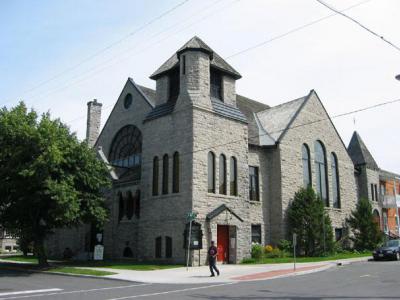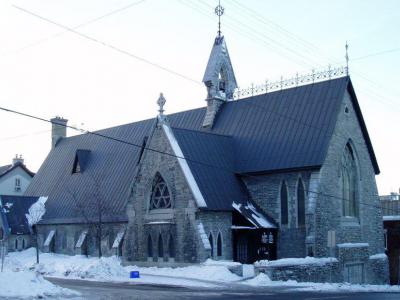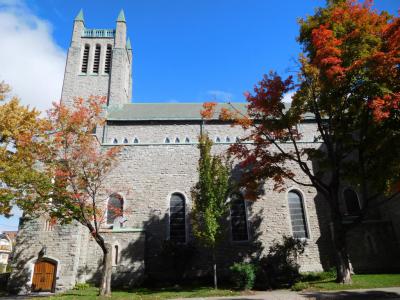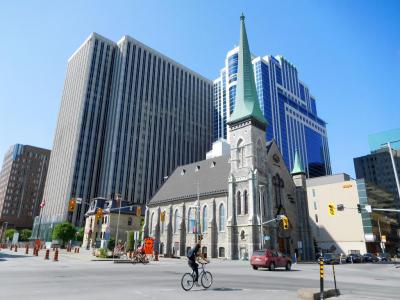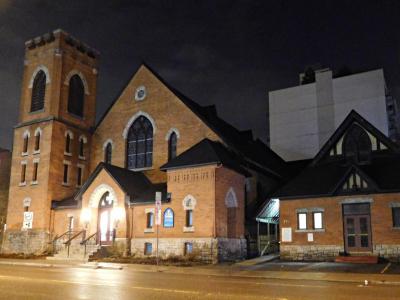Ottawa's Historical Churches Walking Tour (Self Guided), Ottawa
The city of Ottawa has a number of notable religious sites fit to spark interest in both ardent believers and those keen on ecclesiastical architecture. With most of the churches located in the downtown area or nearby, one can visit these locations without trouble.
The Notre Dame Cathedral Basilica, a splendid Gothic Revival masterpiece, is a centerpiece of Ottawa's spiritual landscape. Its intricate stained glass windows and grand arches inspire awe, making it an iconic destination for anyone interested in Ottawa's religious scene.
St. Paul's Eastern United Church, on the other hand, represents a unique blend of architectural styles. This church combines Romanesque and Gothic elements, creating a striking facade that has been welcoming worshipers for over a century.
St. Alban's Anglican Church is a fine example of Gothic Revival architecture. Its somewhat squat structure and elegant interior make it a cozy and cherished site for its congregation and those who appreciate historical ecclesiastical design.
Saint Joseph Parish, a picturesque Catholic church, embodies a more modest yet charming architectural style. Its simple beauty and serene atmosphere offer a peaceful retreat from the bustling city.
First Baptist Church, another architectural gem, set against the backdrop of contemporary high-rising buildings, evokes tender feelings and reminds us of a bygone era.
Knox Presbyterian Church stands proudly with its stunning Gothic Revival design and castle-like stonework – a testament to the city's commitment to preserving its religious heritage.
The Church of Saint John the Evangelist, with its Victorian Gothic style, is yet another architectural treasure. Its red-brick appearance and historic significance make it a compelling stop for architecture and history enthusiasts alike.
The aesthetics and heritage of Ottawa's historical churches offer a glimpse into the diverse culture of Canada's capital. Whatever your interest – architectural marvels, historical significance, or spiritual ambiance – be encouraged to explore these landmarks for a chance to connect with the city's storied past and meaningful present. You won't regret it!
The Notre Dame Cathedral Basilica, a splendid Gothic Revival masterpiece, is a centerpiece of Ottawa's spiritual landscape. Its intricate stained glass windows and grand arches inspire awe, making it an iconic destination for anyone interested in Ottawa's religious scene.
St. Paul's Eastern United Church, on the other hand, represents a unique blend of architectural styles. This church combines Romanesque and Gothic elements, creating a striking facade that has been welcoming worshipers for over a century.
St. Alban's Anglican Church is a fine example of Gothic Revival architecture. Its somewhat squat structure and elegant interior make it a cozy and cherished site for its congregation and those who appreciate historical ecclesiastical design.
Saint Joseph Parish, a picturesque Catholic church, embodies a more modest yet charming architectural style. Its simple beauty and serene atmosphere offer a peaceful retreat from the bustling city.
First Baptist Church, another architectural gem, set against the backdrop of contemporary high-rising buildings, evokes tender feelings and reminds us of a bygone era.
Knox Presbyterian Church stands proudly with its stunning Gothic Revival design and castle-like stonework – a testament to the city's commitment to preserving its religious heritage.
The Church of Saint John the Evangelist, with its Victorian Gothic style, is yet another architectural treasure. Its red-brick appearance and historic significance make it a compelling stop for architecture and history enthusiasts alike.
The aesthetics and heritage of Ottawa's historical churches offer a glimpse into the diverse culture of Canada's capital. Whatever your interest – architectural marvels, historical significance, or spiritual ambiance – be encouraged to explore these landmarks for a chance to connect with the city's storied past and meaningful present. You won't regret it!
How it works: Download the app "GPSmyCity: Walks in 1K+ Cities" from Apple App Store or Google Play Store to your mobile phone or tablet. The app turns your mobile device into a personal tour guide and its built-in GPS navigation functions guide you from one tour stop to next. The app works offline, so no data plan is needed when traveling abroad.
Ottawa's Historical Churches Walking Tour Map
Guide Name: Ottawa's Historical Churches Walking Tour
Guide Location: Canada » Ottawa (See other walking tours in Ottawa)
Guide Type: Self-guided Walking Tour (Sightseeing)
# of Attractions: 7
Tour Duration: 2 Hour(s)
Travel Distance: 3.2 Km or 2 Miles
Author: helenp
Sight(s) Featured in This Guide:
Guide Location: Canada » Ottawa (See other walking tours in Ottawa)
Guide Type: Self-guided Walking Tour (Sightseeing)
# of Attractions: 7
Tour Duration: 2 Hour(s)
Travel Distance: 3.2 Km or 2 Miles
Author: helenp
Sight(s) Featured in This Guide:
- Notre-Dame Cathedral Basilica
- St. Paul's Eastern United Church
- St. Alban's Anglican Church
- Saint Joseph Parish
- First Baptist Church
- Knox Presbyterian Church
- The Church of Saint John the Evangelist
1) Notre-Dame Cathedral Basilica (must see)
Notre-Dame Cathedral Basilica is a true Ottawa treasure – a stunning blend of history, art, and faith right in the city’s heart. This basilica stands where Ottawa’s first Catholic chapel once welcomed parishioners back in the early 19th century, making it the oldest surviving church in the capital. Construction began in 1841, but here’s a fun twist: the original plan was a Neo-classical design, which got a major makeover mid-way when Father Telmon stepped in and switched things up to the now-iconic Neo-Gothic style. So, when you look closely, you’ll spot this unique architectural mashup – classical at the base and soaring Gothic elegance above.
Step inside, and you’ll be greeted by a riot of color and detail that outshines the church’s more modest exterior. The stained glass windows flood the space with vibrant light, telling biblical stories in jewel-like hues. You’ll also find countless statues scattered throughout, with the gold-plated Madonna statue flanked by twin spires standing out as a shining star – literally and figuratively.
Did you know? The basilica has hosted some of Canada’s most significant moments, including the funerals of Governor General Georges Vanier and Prime Minister Sir Wilfrid Laurier, making it a place of deep national importance beyond its spiritual role.
Visitors can explore the basilica freely, and guided tours in English and French are available at no cost, perfect if you want to dig into the stories behind the art and architecture. Don’t miss the marble pillars, though: they’re actually wood cleverly painted to look like marble, a neat detail that’s easy to overlook but adds to the basilica’s charm.
Tip: Check the tour schedule online before you go to catch a guided tour and learn all the hidden stories and secrets tucked inside this magnificent basilica.
Step inside, and you’ll be greeted by a riot of color and detail that outshines the church’s more modest exterior. The stained glass windows flood the space with vibrant light, telling biblical stories in jewel-like hues. You’ll also find countless statues scattered throughout, with the gold-plated Madonna statue flanked by twin spires standing out as a shining star – literally and figuratively.
Did you know? The basilica has hosted some of Canada’s most significant moments, including the funerals of Governor General Georges Vanier and Prime Minister Sir Wilfrid Laurier, making it a place of deep national importance beyond its spiritual role.
Visitors can explore the basilica freely, and guided tours in English and French are available at no cost, perfect if you want to dig into the stories behind the art and architecture. Don’t miss the marble pillars, though: they’re actually wood cleverly painted to look like marble, a neat detail that’s easy to overlook but adds to the basilica’s charm.
Tip: Check the tour schedule online before you go to catch a guided tour and learn all the hidden stories and secrets tucked inside this magnificent basilica.
2) St. Paul's Eastern United Church
Saint Paul's-Eastern United Church, located in Ottawa, is a historic congregation that holds a significant place in the city. Situated in downtown Ottawa's Sandy Hill neighborhood, at the intersection of Daly and Cumberland Streets, the church building is a striking example of Romanesque architecture, constructed using stone. It was originally built in 1888-1889 by architect S.R. Badgley for Saint Paul's Presbyterian Church, featuring a prominent steeple.
Unfortunately, the church was built on sand, and the steeple side started sinking into the ground. The steeple was therefore removed early in the 20th century, leaving the building as a relatively squat stone structure.
In 1925, with the establishment of the United Church of Canada, Saint Paul's merged with the neighboring Eastern Methodist Church and adopted its current name.
In recent years (2003-present), there has been a resurgence of activity, membership, financial stability, and Sunday school involvement at Saint Paul's-Eastern. The church has attracted many young families and singles who have brought new energy and life to the community. Saint Paul's-Eastern serves as a hub for various groups and partners who utilize the church's facilities. These include organizations such as Jericho Road and Touch of Love, as well as external groups like the Girl Guides and Alcoholics Anonymous.
Unfortunately, the church was built on sand, and the steeple side started sinking into the ground. The steeple was therefore removed early in the 20th century, leaving the building as a relatively squat stone structure.
In 1925, with the establishment of the United Church of Canada, Saint Paul's merged with the neighboring Eastern Methodist Church and adopted its current name.
In recent years (2003-present), there has been a resurgence of activity, membership, financial stability, and Sunday school involvement at Saint Paul's-Eastern. The church has attracted many young families and singles who have brought new energy and life to the community. Saint Paul's-Eastern serves as a hub for various groups and partners who utilize the church's facilities. These include organizations such as Jericho Road and Touch of Love, as well as external groups like the Girl Guides and Alcoholics Anonymous.
3) St. Alban's Anglican Church
Saint Albans Anglican Church is a historic Anglican church located in the Sandy Hill neighborhood of Ottawa. It holds the distinction of being one of the oldest surviving church buildings in Ottawa. The church was established in 1865, and its original design was created in 1866 by Thomas Fuller, who was also the architect behind Canada's original Parliament Buildings.
The construction of Saint Albans began in 1867, following the laying of the cornerstone on May 9 of the same year. It was completed in 1868, with the chancel and vestry being finished later by King McCord Arnoldi in 1876-77. The church's location on a steep hill at the corner of King Edward and Daly posed challenges, resulting in Fuller's initial plans being significantly scaled back. Nevertheless, the church attracted prominent figures, including early political leaders of Canada like Sir John A. Macdonald.
Saint Albans Anglican Church is named after Saint Alban, the first British Christian martyr, who was known for providing refuge and support to the oppressed and terrified.
Recognizing its historical significance, the building holds a Municipal designation under the Ontario Heritage Act, Section 29, and is subject to an easement agreement with the Ontario Heritage Trust.
The construction of Saint Albans began in 1867, following the laying of the cornerstone on May 9 of the same year. It was completed in 1868, with the chancel and vestry being finished later by King McCord Arnoldi in 1876-77. The church's location on a steep hill at the corner of King Edward and Daly posed challenges, resulting in Fuller's initial plans being significantly scaled back. Nevertheless, the church attracted prominent figures, including early political leaders of Canada like Sir John A. Macdonald.
Saint Albans Anglican Church is named after Saint Alban, the first British Christian martyr, who was known for providing refuge and support to the oppressed and terrified.
Recognizing its historical significance, the building holds a Municipal designation under the Ontario Heritage Act, Section 29, and is subject to an easement agreement with the Ontario Heritage Trust.
4) Saint Joseph Parish
Saint Joseph's is a small, traditional Roman Catholic parish located in Ottawa, known for its stone-made structure. The church was established in 1856, believed to have been built on what was once a burial ground for the laborers who lost their lives during the construction of the Rideau Canal.
The Roman Catholic Church received portions of the land in 1845, which were allocated for the construction of a church and college. This area later became the site of Saint Joseph's Parish and the College of Ottawa.
The church was consecrated in 1858 and boasted unique architectural elements such as a clock above the entrance and the first church bells in Ottawa. Initially, it could accommodate 230 parishioners. As Ottawa became the capital of Canada, the population in the area increased, and more people began attending church services. In 1866, additional benches were added to increase the seating capacity of Saint Joseph's.
In 1893, a new church was constructed to replace the original Saint Joseph's. This new church had a seating capacity of 1100 individuals and was built in the Roman Renaissance style. Unfortunately, it stood for only 37 years before being destroyed by a fire on December 27, 1930.
A third church was then constructed on the foundations of the second Saint Joseph's, incorporating some parts of the previous structure. However, the architectural style shifted from Roman Renaissance to Neo-Gothic. The present church is known to be more inclusive, allowing greater participation of women in the services.
The Roman Catholic Church received portions of the land in 1845, which were allocated for the construction of a church and college. This area later became the site of Saint Joseph's Parish and the College of Ottawa.
The church was consecrated in 1858 and boasted unique architectural elements such as a clock above the entrance and the first church bells in Ottawa. Initially, it could accommodate 230 parishioners. As Ottawa became the capital of Canada, the population in the area increased, and more people began attending church services. In 1866, additional benches were added to increase the seating capacity of Saint Joseph's.
In 1893, a new church was constructed to replace the original Saint Joseph's. This new church had a seating capacity of 1100 individuals and was built in the Roman Renaissance style. Unfortunately, it stood for only 37 years before being destroyed by a fire on December 27, 1930.
A third church was then constructed on the foundations of the second Saint Joseph's, incorporating some parts of the previous structure. However, the architectural style shifted from Roman Renaissance to Neo-Gothic. The present church is known to be more inclusive, allowing greater participation of women in the services.
5) First Baptist Church
The First Baptist Church, located in Ottawa, is a Baptist church associated with the Canadian Baptists of Ontario and Quebec.
Established in 1857, it was the first Baptist congregation in Ottawa. The present-day church is prominently situated at the intersection of Elgin Street and Laurier Avenue West in Downtown Ottawa. It was designed by architect James Mather and constructed between 1877 and 1878. The cornerstone was laid by Alexander Mackenzie, who served as the Prime Minister at that time. Mackenzie, being a Baptist himself, attended services at the church during his stays in Ottawa once services began in 1878.
Over the years, the First Baptist Church Ottawa has commemorated the members of its congregation who served in and sacrificed their lives during the Great War and the Second World War. They have erected memorial plaques in their honor.
In 1916, the church underwent expansion, and in 1928, it underwent significant renovations. To mark Canada's Centennial in 1967, a large organ was installed. Restoration work was carried out from 1999 to 2002.
Throughout its history, the congregation has remained in the downtown area and has actively supported the establishment of new congregations, including McPhail Memorial Baptist Church in 1896, Fourth Avenue Baptist Church in The Glebe in 1899, and more recently, Kanata Baptist Church and Bilberry Creek Baptist Church in Orleans.
Established in 1857, it was the first Baptist congregation in Ottawa. The present-day church is prominently situated at the intersection of Elgin Street and Laurier Avenue West in Downtown Ottawa. It was designed by architect James Mather and constructed between 1877 and 1878. The cornerstone was laid by Alexander Mackenzie, who served as the Prime Minister at that time. Mackenzie, being a Baptist himself, attended services at the church during his stays in Ottawa once services began in 1878.
Over the years, the First Baptist Church Ottawa has commemorated the members of its congregation who served in and sacrificed their lives during the Great War and the Second World War. They have erected memorial plaques in their honor.
In 1916, the church underwent expansion, and in 1928, it underwent significant renovations. To mark Canada's Centennial in 1967, a large organ was installed. Restoration work was carried out from 1999 to 2002.
Throughout its history, the congregation has remained in the downtown area and has actively supported the establishment of new congregations, including McPhail Memorial Baptist Church in 1896, Fourth Avenue Baptist Church in The Glebe in 1899, and more recently, Kanata Baptist Church and Bilberry Creek Baptist Church in Orleans.
6) Knox Presbyterian Church
Knox Presbyterian Church, situated in Ottawa, is a Presbyterian Church that bears the name of John Knox, a prominent figure in the establishment of Presbyterianism in Scotland.
The original Knox Church, designed by Donald Kennedy in 1845, was situated in Sandy Hill at the intersection of Daly Avenue and Cumberland. In 1874, the Knox congregation relocated downtown, leaving their building to Saint Paul's Presbyterian, which later became Saint Paul's-Eastern United Church (Eastern Methodist) following the church union in 1925.
The second Knox Church, located near the Second City Hall (Ottawa) on Elgin Street, now occupied by the National Arts Centre, housed the Regimental and King's Colours of the 207th Battalion in 1919. These artifacts are now displayed in the current church, along with a plaque honoring the memory of the 207th Battalion, CEF veterans.
In 1930, the City of Ottawa expropriated the area to widen Elgin Street, compelling Knox Church, which had remained part of the Presbyterian Church in Canada since 1925, to move a few blocks away to its current location at the corner of Lisgar and Elgin. The second church was subsequently demolished in 1932.
The present-day Knox Church building, designed by John Albert Ewart and Henry Sproatt in 1931, was opened in 1932. The church has had the honor of hosting the General Assembly of the Presbyterian Church in Canada on three occasions.
The original Knox Church, designed by Donald Kennedy in 1845, was situated in Sandy Hill at the intersection of Daly Avenue and Cumberland. In 1874, the Knox congregation relocated downtown, leaving their building to Saint Paul's Presbyterian, which later became Saint Paul's-Eastern United Church (Eastern Methodist) following the church union in 1925.
The second Knox Church, located near the Second City Hall (Ottawa) on Elgin Street, now occupied by the National Arts Centre, housed the Regimental and King's Colours of the 207th Battalion in 1919. These artifacts are now displayed in the current church, along with a plaque honoring the memory of the 207th Battalion, CEF veterans.
In 1930, the City of Ottawa expropriated the area to widen Elgin Street, compelling Knox Church, which had remained part of the Presbyterian Church in Canada since 1925, to move a few blocks away to its current location at the corner of Lisgar and Elgin. The second church was subsequently demolished in 1932.
The present-day Knox Church building, designed by John Albert Ewart and Henry Sproatt in 1931, was opened in 1932. The church has had the honor of hosting the General Assembly of the Presbyterian Church in Canada on three occasions.
7) The Church of Saint John the Evangelist
The Church of Saint John the Evangelist is an Anglican temple in Ottawa. Its history goes back to the 19th century to a church built in 1853 for Anglican soldiers posted in Bytown. In 1861, it was replaced with a small Chapel of Ease whose name was then changed to Saint John's in 1871, courtesy of Bishop John Lewis, who wished to set up a pro-cathedral of the Diocese of Ontario.
In 1889, an uproar broke out in the neighbouring Saint George’s Church on liturgy, following which a group of thirty people left the congregation with a plan to build a church of their own. Architect Mr. J. Hames was hired to do the design and the construction got underway with the cornerstone laid on October 21, 1890. Within a year, the church was completed and sanctified as Grace Church.
In 1912, a terrible fire ravaged Saint John’s church. After that, Saint John’s and Grace Church were merged in 1913 to form what's since been known as The Church of Saint John the Evangelist. The interior of this church is clad totally in wood and embellished with several stained-glass windows, while the outer walls feature brick- and stonework.
The Church of Saint John the Evangelist has been long known for its benign attitude toward gay people. Its first rector, Canon Gorman, had a son who was gay, and was much loved and well remembered by the parishioners. Gay people were energetic members of the local community in the 1960s and 1970s. When the epidemic of AIDS stroke in the mid 1980s, the gay community were given full support by Saint John’s.
Saint John’s is equally dedicated to both prayer and the community work. Its activities include arranging political meetings, organizing concerts, housing art festivals along with many other events beneficial to the whole community.
In 1889, an uproar broke out in the neighbouring Saint George’s Church on liturgy, following which a group of thirty people left the congregation with a plan to build a church of their own. Architect Mr. J. Hames was hired to do the design and the construction got underway with the cornerstone laid on October 21, 1890. Within a year, the church was completed and sanctified as Grace Church.
In 1912, a terrible fire ravaged Saint John’s church. After that, Saint John’s and Grace Church were merged in 1913 to form what's since been known as The Church of Saint John the Evangelist. The interior of this church is clad totally in wood and embellished with several stained-glass windows, while the outer walls feature brick- and stonework.
The Church of Saint John the Evangelist has been long known for its benign attitude toward gay people. Its first rector, Canon Gorman, had a son who was gay, and was much loved and well remembered by the parishioners. Gay people were energetic members of the local community in the 1960s and 1970s. When the epidemic of AIDS stroke in the mid 1980s, the gay community were given full support by Saint John’s.
Saint John’s is equally dedicated to both prayer and the community work. Its activities include arranging political meetings, organizing concerts, housing art festivals along with many other events beneficial to the whole community.
Walking Tours in Ottawa, Canada
Create Your Own Walk in Ottawa
Creating your own self-guided walk in Ottawa is easy and fun. Choose the city attractions that you want to see and a walk route map will be created just for you. You can even set your hotel as the start point of the walk.
Ottawa Introduction Walking Tour
Perched on the banks of the Ottawa River, the Canadian capital has story that began long before Parliament’s iconic Gothic towers pierced the skyline. For thousands of years, this land was home to the Algonquin Anishinaabe people, whose traditional territory stretched along the river’s length. The word “Ottawa” itself comes from adawe, meaning “to trade,” a nod to the waterway’s... view more
Tour Duration: 2 Hour(s)
Travel Distance: 2.8 Km or 1.7 Miles
Tour Duration: 2 Hour(s)
Travel Distance: 2.8 Km or 1.7 Miles
Historical Buildings Walking Tour
The architecture of Ottawa – formalistic and functional, for the most part – is marked by the city's role as the national capital of Canada. As such, it represents a mix of styles, varying considerably based on the era of construction of any particular object, and reflects the nation's heritage and political significance.
Centermost among these structures is the Parliament... view more
Tour Duration: 1 Hour(s)
Travel Distance: 1.9 Km or 1.2 Miles
Centermost among these structures is the Parliament... view more
Tour Duration: 1 Hour(s)
Travel Distance: 1.9 Km or 1.2 Miles
Statues and Sculptures Walk
As a cultural city, Ottawa abounds in monuments and statues of various sorts. In fact, there are so many of them that the locals, accustomed to their presence, jokingly claim they hardly notice them at all. Still, these artistic creations serve as visual storytellers, sharing tales of courage, peacekeeping, and commemoration.
The Maman Statue, a prominent sculpture located outside the National... view more
Tour Duration: 1 Hour(s)
Travel Distance: 1.4 Km or 0.9 Miles
The Maman Statue, a prominent sculpture located outside the National... view more
Tour Duration: 1 Hour(s)
Travel Distance: 1.4 Km or 0.9 Miles
The Most Popular Cities
/ view all




